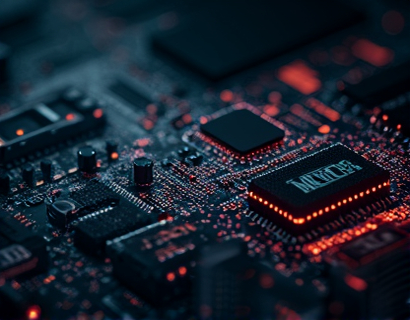Next-Gen Smart Contract AMMs: Revolutionizing DeFi Trading with Advanced Automation and Liquidity Management
The decentralized finance (DeFi) ecosystem has witnessed unprecedented growth and innovation, with smart contract-based Automated Market Makers (AMMs) emerging as a cornerstone of this transformation. These AMMs leverage advanced automation and liquidity management to redefine the trading experience, offering crypto traders and DeFi enthusiasts unparalleled efficiency and seamless market interactions. This article delves into the cutting-edge technology behind next-generation smart contract AMMs, exploring how they optimize liquidity management and automate trading strategies to ensure optimal performance in the dynamic crypto landscape.
Understanding Smart Contract AMMs
Traditional AMMs rely on algorithms to determine asset prices and manage liquidity pools, eliminating the need for order books and human intervention. Smart contract AMMs take this a step further by deploying on blockchain networks, ensuring transparency, security, and immutability. These contracts execute predefined rules automatically, facilitating trades without intermediaries. The use of smart contracts in AMMs not only reduces costs but also enhances trust among participants, as all transactions are verifiable and tamper-proof.
The core mechanism of a smart contract AMM involves liquidity pools, where users deposit assets to create a pool. These pools are used for trading, and participants are rewarded with liquidity provider (LP) tokens. The price of assets in the pool is determined by the ratio of the two assets in the pool, typically using a constant product formula such as x * y = k, where x and y are the amounts of the two assets, and k is a constant. This formula ensures that the price remains stable relative to the pool's composition.
Advanced Automation in AMMs
Next-generation smart contract AMMs incorporate advanced automation features that go beyond basic liquidity provision and trading. These features include algorithmic trading, risk management, and automated rebalancing, which collectively enhance the trading experience and optimize portfolio performance.
Algorithmic trading allows users to execute complex trading strategies automatically, based on predefined criteria such as price movements, volume, and market conditions. Smart contract AMMs can integrate with external oracles to fetch real-time market data, enabling algorithms to make informed decisions. This automation not only saves time but also reduces emotional biases, leading to more consistent and profitable trading outcomes.
Risk management is another critical aspect of advanced AMMs. These platforms employ sophisticated risk assessment models to monitor and mitigate potential losses. Features such as stop-loss orders, position sizing, and diversification strategies are built into the smart contracts, ensuring that users can manage their exposure effectively. By automating these processes, users can focus on higher-level decision-making while the system handles the intricacies of risk control.
Automated rebalancing is a powerful feature that maintains the desired asset allocation in a portfolio. As market conditions change, the relative values of assets in a liquidity pool can drift from the target ratios. Smart contract AMMs can automatically rebalance the pool by buying or selling assets to restore the desired balance. This ensures that liquidity providers benefit from consistent returns and reduces the risk of impermanent loss, a common concern in traditional AMMs.
Optimizing Liquidity Management
Liquidity management is a fundamental challenge in DeFi, and smart contract AMMs address this through innovative solutions. One key approach is the use of dynamic fee structures, which adjust based on market conditions and liquidity levels. During periods of high volatility or low liquidity, fees can increase to incentivize more liquidity provision, ensuring that the pool remains robust and attractive to traders. Conversely, during stable periods, fees can be reduced to encourage more trading activity and user engagement.
Another advanced feature is the implementation of liquidity incentives, such as yield farming and staking rewards. Users can earn additional tokens by providing liquidity to specific pools, which are calculated based on their contribution and the pool's performance. Smart contracts can automate these rewards, ensuring that liquidity providers are motivated to participate and stay engaged.
Cross-chain liquidity is another area where next-gen AMMs excel. By supporting multiple blockchain networks, these platforms enable users to access a broader range of assets and trading opportunities. Smart contracts can facilitate atomic swaps and interoperability protocols, allowing seamless transfers between different chains. This not only enhances liquidity but also fosters a more interconnected DeFi ecosystem.
Enhancing User Experience through Automation
The user experience in DeFi trading is significantly improved through advanced automation in smart contract AMMs. One notable feature is the one-click trading interface, which simplifies the process of executing trades, managing positions, and monitoring performance. Users can set up automated trading bots with a few clicks, specifying parameters such as entry and exit points, stop-loss levels, and target returns. The smart contract handles all the execution, ensuring that trades are carried out precisely as intended.
Real-time monitoring and alerts are also integral to the user experience. Smart contracts can send notifications to users via integrated messaging protocols or external services, alerting them to significant events such as price breaks, liquidity thresholds, or portfolio rebalancing needs. This keeps users informed and allows them to take timely actions, even when they are not actively monitoring the platform.
Furthermore, the integration of user-friendly dashboards and visualization tools enhances the overall experience. These dashboards provide comprehensive insights into portfolio performance, liquidity provision, and trading activity. Users can easily track their assets, view historical data, and analyze market trends, all within a single, intuitive interface. This level of transparency and control empowers users to make informed decisions and maximize their returns.
Security and Trust in Smart Contract AMMs
Security is paramount in the DeFi space, and smart contract AMMs are designed with robust security measures to protect user assets and ensure trust. Smart contracts are audited by leading security firms to identify and mitigate vulnerabilities before deployment. Additionally, formal verification techniques are employed to mathematically prove the correctness of the contract logic, reducing the risk of bugs and exploits.
Transparency is another cornerstone of security in smart contract AMMs. All contract code is open-source, allowing the community to review and audit the code independently. This openness fosters a culture of collaboration and accountability, as any potential issues can be identified and addressed promptly. Users can also access detailed documentation and explanations of the smart contract logic, further enhancing trust and understanding.
To further enhance security, smart contract AMMs implement multi-signature wallets and cold storage for asset holding. This ensures that funds are stored offline and require multiple approvals for any transactions, minimizing the risk of unauthorized access. Additionally, insurance mechanisms can be integrated to protect users against smart contract failures or external attacks, providing an extra layer of security and peace of mind.
Future Prospects and Innovations
The future of smart contract AMMs is bright, with ongoing innovations poised to push the boundaries of DeFi trading. One exciting development is the integration of machine learning and artificial intelligence to enhance algorithmic trading and risk management. AI-driven models can analyze vast amounts of data to identify patterns and predict market movements, enabling more sophisticated and adaptive trading strategies.
Another area of innovation is the development of decentralized prediction markets within AMMs. These markets allow users to bet on future events, such as price movements or regulatory changes, using smart contracts to manage bets and payouts. This not only adds a new dimension to trading but also provides valuable insights into market sentiment and expectations.
Interoperability is also a key focus, with efforts to create cross-chain AMMs that can seamlessly integrate with various blockchain ecosystems. This will unlock new opportunities for liquidity and trading, breaking down silos and fostering a more unified DeFi landscape. Standardization of protocols and interoperability frameworks will play a crucial role in achieving this vision.
Lastly, the exploration of new tokenomics and governance models within AMMs is set to revolutionize user participation and platform sustainability. Token holders can vote on protocol upgrades, fee structures, and other critical decisions, ensuring that the AMM evolves in line with user needs and market dynamics. This decentralized governance model empowers the community and aligns incentives, fostering long-term growth and adoption.











































